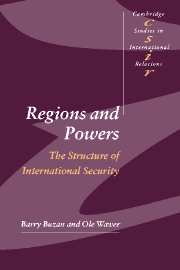Book contents
- Frontmatter
- Contents
- List of illustrations
- Preface
- List of abbreviations
- 1 Patterns of regional security during the Cold War
- 2 Patterns of regional security post-Cold War
- Part I Introduction: developing a regional approach to global security
- Part II Asia
- Part III The Middle East and Africa
- Part IV The Americas
- Part V The Europes
- Part VI Conclusions
- Introduction
- 14 Regions and powers: summing up and looking ahead
- 15 Reflections on conceptualising international security
- Glossary
- References
- News media
- Index of names
- General Index
- CAMBRIDGE STUDIES IN INTERNATIONAL RELATIONS
Introduction
Published online by Cambridge University Press: 05 December 2009
- Frontmatter
- Contents
- List of illustrations
- Preface
- List of abbreviations
- 1 Patterns of regional security during the Cold War
- 2 Patterns of regional security post-Cold War
- Part I Introduction: developing a regional approach to global security
- Part II Asia
- Part III The Middle East and Africa
- Part IV The Americas
- Part V The Europes
- Part VI Conclusions
- Introduction
- 14 Regions and powers: summing up and looking ahead
- 15 Reflections on conceptualising international security
- Glossary
- References
- News media
- Index of names
- General Index
- CAMBRIDGE STUDIES IN INTERNATIONAL RELATIONS
Summary
In the preceding chapters we have first set out our theory, and then applied it to all regions of the world. We have not been trying to ‘test’ some single formal relationship of cause and effect. Rather, we have been applying a systematic framework of concepts and expectations to a complicated period of world history. Our aim has been to see whether our concepts and expectations fit well enough into this world history to enable us (and others) to make a general interpretation of the structure of international security as well as specific and comparative interpretations of different regions.
Because we were constantly held in check by people with much deeper expertise than ours about the regions, the most important learning experience for us was in the tension between, on the one hand, our initial ideas about how the empirical material might be decanted into our theoretical containers and, on the other, our growing understanding of the specificity and uniqueness of each individual region. The result of this tension is a set of case studies that are all underpinned by the same set of questions, but whose main plots and themes often differ markedly. While we have tried to compare systematically on a number of dimensions, the individuality of each region demanded that the main synthesising plot(s) for each chapter be allowed to structure how the story was told.
- Type
- Chapter
- Information
- Regions and PowersThe Structure of International Security, pp. 443 - 444Publisher: Cambridge University PressPrint publication year: 2003

